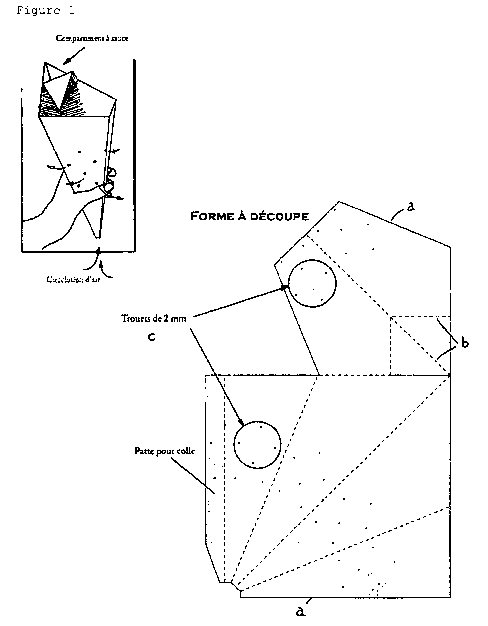Une partie des informations de ce site Web a été fournie par des sources externes. Le gouvernement du Canada n'assume aucune responsabilité concernant la précision, l'actualité ou la fiabilité des informations fournies par les sources externes. Les utilisateurs qui désirent employer cette information devraient consulter directement la source des informations. Le contenu fourni par les sources externes n'est pas assujetti aux exigences sur les langues officielles, la protection des renseignements personnels et l'accessibilité.
L'apparition de différences dans le texte et l'image des Revendications et de l'Abrégé dépend du moment auquel le document est publié. Les textes des Revendications et de l'Abrégé sont affichés :
| (12) Demande de brevet: | (11) CA 2812147 |
|---|---|
| (54) Titre français: | CORNET DE FRITES |
| (54) Titre anglais: | CONE FOR CHIPS |
| Statut: | Réputée abandonnée et au-delà du délai pour le rétablissement - en attente de la réponse à l’avis de communication rejetée |
| (51) Classification internationale des brevets (CIB): |
|
|---|---|
| (72) Inventeurs : |
|
| (73) Titulaires : |
|
| (71) Demandeurs : |
|
| (74) Agent: | MARKS & CLERK |
| (74) Co-agent: | |
| (45) Délivré: | |
| (86) Date de dépôt PCT: | 2011-09-14 |
| (87) Mise à la disponibilité du public: | 2012-03-22 |
| Licence disponible: | S.O. |
| Cédé au domaine public: | S.O. |
| (25) Langue des documents déposés: | Anglais |
| Traité de coopération en matière de brevets (PCT): | Oui |
|---|---|
| (86) Numéro de la demande PCT: | PCT/EP2011/065904 |
| (87) Numéro de publication internationale PCT: | WO 2012035043 |
| (85) Entrée nationale: | 2013-03-13 |
| (30) Données de priorité de la demande: | ||||||
|---|---|---|---|---|---|---|
|
La présente invention concerne généralement un cornet de frites. Le modèle présenté ici propose, à la base du cornet, une petite ouverture et au milieu des quatre faces, une série de trouets. Ces diverses ouvertures permettent une circulation d'air. Celle-ci empêche la formation de vapeur produite par la chaleur des frites, garde les frites bien croustillantes et permet au cornet de rester bien rigide tout au long de son utilisation. Dans une réalisation, le cornet à un compartiment situé au sommet intérieur du cornet et intégré dans celui-ci, peut être déplié afin de recevoir la sauce.
The present invention generally relates to a French fry cone. The model presented here includes a small opening at the base of the cone, and a series of small holes in the middle of the four surfaces. The various openings enable the circulation of air. The circulation of air prevents the formation of water vapor due to the heat of the French fries, keeps the French fries crispy, and enables the cone to remain rigid throughout the use thereof. In one embodiment, the cone has a compartment which is located at the inner top thereof and which is built therein, and which can be unfolded receive sauce.
Note : Les revendications sont présentées dans la langue officielle dans laquelle elles ont été soumises.
Note : Les descriptions sont présentées dans la langue officielle dans laquelle elles ont été soumises.

2024-08-01 : Dans le cadre de la transition vers les Brevets de nouvelle génération (BNG), la base de données sur les brevets canadiens (BDBC) contient désormais un Historique d'événement plus détaillé, qui reproduit le Journal des événements de notre nouvelle solution interne.
Veuillez noter que les événements débutant par « Inactive : » se réfèrent à des événements qui ne sont plus utilisés dans notre nouvelle solution interne.
Pour une meilleure compréhension de l'état de la demande ou brevet qui figure sur cette page, la rubrique Mise en garde , et les descriptions de Brevet , Historique d'événement , Taxes périodiques et Historique des paiements devraient être consultées.
| Description | Date |
|---|---|
| Inactive : CIB expirée | 2017-01-01 |
| Demande non rétablie avant l'échéance | 2015-09-15 |
| Le délai pour l'annulation est expiré | 2015-09-15 |
| Réputée abandonnée - omission de répondre à un avis sur les taxes pour le maintien en état | 2014-09-15 |
| Inactive : Page couverture publiée | 2013-06-07 |
| Inactive : Notice - Entrée phase nat. - Pas de RE | 2013-05-27 |
| Inactive : CIB attribuée | 2013-04-23 |
| Inactive : Demandeur supprimé | 2013-04-23 |
| Inactive : CIB attribuée | 2013-04-23 |
| Demande reçue - PCT | 2013-04-23 |
| Inactive : CIB en 1re position | 2013-04-23 |
| Inactive : CIB attribuée | 2013-04-23 |
| Inactive : CIB attribuée | 2013-04-23 |
| Inactive : CIB attribuée | 2013-04-23 |
| Exigences pour l'entrée dans la phase nationale - jugée conforme | 2013-03-13 |
| Demande publiée (accessible au public) | 2012-03-22 |
| Date d'abandonnement | Raison | Date de rétablissement |
|---|---|---|
| 2014-09-15 |
Le dernier paiement a été reçu le 2013-03-13
Avis : Si le paiement en totalité n'a pas été reçu au plus tard à la date indiquée, une taxe supplémentaire peut être imposée, soit une des taxes suivantes :
Veuillez vous référer à la page web des taxes sur les brevets de l'OPIC pour voir tous les montants actuels des taxes.
| Type de taxes | Anniversaire | Échéance | Date payée |
|---|---|---|---|
| TM (demande, 2e anniv.) - générale | 02 | 2013-09-16 | 2013-03-13 |
| Taxe nationale de base - générale | 2013-03-13 |
Les titulaires actuels et antérieures au dossier sont affichés en ordre alphabétique.
| Titulaires actuels au dossier |
|---|
| LUC SEGERS |
| ANTONIO MALANDRINI |
| DERWA, LOUIS |
| Titulaires antérieures au dossier |
|---|
| S.O. |